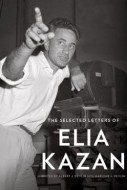Book Review: The Selected Letters of Elia Kazan
The Selected Letters of Elia Kazan
Kazan, Elia
Edited by Albert J. Devlin ; with Marlene J. Devlin
Knopf Doubleday Publishing Group, 2014
ISBN: 978-0307267160
649 pp.
Albert and Marlene Devlin’s The Selected Letters of Elia Kazan paints a vivid portrait of the legendary director’s life and times that is frequently at odds with the tightly controlled persona presented in his autobiography, Elia Kazan: A Life. The letters ofKazan take the reader behind the scenes of the Group Theatre, the world premieres of A Streetcar Named Desire and Death of A Salesman, the film East of Eden, and a short lived attempt to found a national repertory theatre, with a candor that comes from private correspondence (some of it composed but never sent).
Kazan masterfully used the epistolary form to facilitate theatrical collaborations with writers Tennessee Williams, John Steinbeck, and Arthur Miller. One gets a sense of his technique of analyzing a script and directing rewrites on Cat On A Hot Tin Roof, Viva Zapata, and On the Waterfront. The greatest American playwrights of his era depended so much on his contributions that he had to discuss with Eric Bentley why he shouldn’t be credited as a co-writer.
Kazan also maintained collaborative relationships with the finest actors of his day. Letters to James Dean, Marlon Brando, and Robert De Niro give insight into his technique of crafting finely controlled and emotionally spontaneous performances that became exemplars of a modern tradition of acting.
The letters also demonstrate Kazan’s mastery of the film medium in all of its varied aspects through his correspondence to studio heads, cameramen, scriptwriters and producers. He proved savvy in every element of the process, from developing the screenplay to marketing the final product. His detailed instructions on publicity and film release strategy show a side of his expertise previously unknown to all but his colleagues.
Perhaps most fascinating are the projects that never came to fruition. His letters to Richard Burton on a proposed Broadway production of “King Lear” (it was scuttled because Burton refused to perform the demanding role seven times a week), and descriptions of a Robert Bolt scripted adaptation of The Oresteia to be performed at Lincoln Center, simultaneously tantalize and frustrate with the prospect of theatrical gold never to be mined.
His controversial decision to name names to the House Un-American Activities Committee is documented more sparsely than would be desired. However, that may be a function of Kazan not referring to his testimony in his correspondence. The footnotes give an impartial account of the incident and more telling are the oblique references to the reaction of various colleagues and his unapologetic defense of his actions throughout the rest of his career.
Kazan’s journey from his membership in the Group Theatre, where he was more renowned for the production of props than acting or directing, through his involvement with many classics of Postwar American Drama, his reign as the pre-eminent film maker of the fifties, and his later life rebirth as a novelist, is presented with a welcome lack of self-consciousness. We encounter Kazan not as a raconteur, but a working artist in constant motion. This volume is highly recommended for all theatre collections.
John Frank
Los Angeles Public Library

